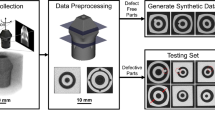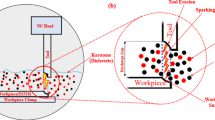Abstract
Milling is a key manufacturing process that requires the selection of operating parameters that provide efficient performance. However, the presence of chatter, a self-excited vibration causing poor surface finish and potential damage to the machine and cutting tool, makes it challenging to select the appropriate parameters. To predict chatter, stability maps are commonly used, but their generation requires expensive data, making it difficult to employ these maps in industry. Therefore, there is a pressing need for an approach that can accurately predict stability maps using limited experimental data. This study introduces the new Encoder GAN (EGAN) approach based on Generative Adversarial Networks (GANs) that predicts stability maps using limited experimental data. The approach consists of the encoder, generator, and discriminator subnetworks and uses the trained encoder and generator to predict the target stability map. This versatile method can be applied to various tool setups and can accurately predict stability maps with limited experimental data (five to 10 cutting tests) even when there is little information available for unknown parameters. The study evaluates the proposed approach using both numerical data and experiments and demonstrates its superior performance compared to state-of-the-art benchmarks.




























Similar content being viewed by others
Data availability
The data that support the findings of this study are available at https://github.com/srezaei90/GANs-to-predict-stability-maps-in-milling-machining.git.
Notes
The code is available at https://github.com/srezaei90/GANs-to-predict-stability-maps-in-milling-machining.git.
References
Akcay, S., Atapour-Abarghouei, A., Breckon, T. P. (2019). Skip-ganomaly: Skip connected and adversarially trained encoder-decoder anomaly detection. In 2019 international joint conference on neural networks (IJCNN) (pp. 1–8). IEEE.
Altintas, Y., & Budak, E. (1995). Analytical prediction of stability lobes in milling. CIRP Annals, 44(1), 357–362.
Arjovsky, M., Chintala, S., & Bottou, L. (2017). Wasserstein generative adversarial networks. PMLR: In International conference on machine learning (pp. 214–223).
Bang, D., & Shim, H. (2018). Improved training of generative adversarial networks using representative features. In International conference on machine learning (pp. 433–442).
Bang, D., & Shim, H. (2021). Mggan: Solving mode collapse using manifold-guided training. In Proceedings of the IEEE/CVF international conference on computer vision (pp. 2347–2356).
Budak, E., & Altintas, Y. (1998). Analytical prediction of chatter stability in milling-Part I: General formulation.
Campatelli, G., & Scippa, A. (2012). Prediction of milling cutting force coefficients for aluminum 6082–t4. Procedia Cirp, 1, 563–568.
Chakraborty, A., Alam, M., Dey, V., Chattopadhyay, A., & Mukhopadhyay, D. (2018). Adversarial attacks and defences: A survey. arXiv preprint arXiv:1810.00069
Chen, G., Li, Y., Liu, X., & Yang, B. (2021). Physics-informed bayesian inference for milling stability analysis. International Journal of Machine Tools and Manufacture, 167, 103767.
Cherukuri, H., Perez-Bernabeu, M., Selles, E., & Schmitz, T. (2019). Machining chatter prediction using a data learning model. Journal of Manufacturing and Materials Processing, 3(2), 45.
Chong, P., Ruff, L., Kloft, M., & Binder, A. (2020). Simple and effective prevention of mode collapse in deep one-class classification. In 2020 international joint conference on neural networks (IJCNN) (pp. 1–9).
Cornelius, A., Karandikar, J., Gomez, M., & Schmitz, T. (2021). A bayesian framework for milling stability prediction and reverse parameter identification. Procedia Manufacturing, 53, 760–772.
Dang, J. W., Zhang, Y., Yang, W. H., & Wan, M. (2010). Cutting force modeling for flat end milling including bottom edge cutting effect. International Journal of Machine Tools and Manufacture, 50(11), 986–997.
Deng, C., Tang, J., Lu, S., Ma, Y., Lin, L., & Miao, J. (2023). Improved milling stability analysis for chatter-free machining parameters planning using a multi-fidelity surrogate model and transfer learning with limited experimental data. International Journal of Production Research, 1–18.
Deng, C., Tang, J., Miao, J., Zhao, Y., Chen, X., & Lu, S. (2023). Efficient stability prediction of milling process with arbitrary tool-holder combinations based on transfer learning. Journal of Intelligent Manufacturing, 34(5), 2263–2279.
Ding, Y., Zhu, L., Zhang, X., & Ding, H. (2010). A full-discretization method for prediction of milling stability. International Journal of Machine Tools and Manufacture, 50(5), 502–509.
Espindola, R. P., & Ebecken, N. F. (2005). On extending f-measure and g-mean metrics to multi-class problems. WIT Transactions on Information and Communication Technologies, 35, 25–34.
Eynian, M. (2019). In-process identification of modal parameters using dimensionless relationships in milling chatter. International Journal of Machine Tools and Manufacture, 143, 49–62.
Friedrich, J., Hinze, C., Renner, A., Verl, A., & Lechler, A. (2017). Estimation of stability lobe diagrams in milling with continuous learning algorithms. Robotics and Computer-Integrated Manufacturing, 43, 124–134.
Goodfellow, I. (2016). Nips 2016 tutorial: Generative adversarial networks. arXiv preprint arXiv:1701.00160
Goodfellow, I., Pouget-Abadie, J., Mirza, M., Xu, B., Warde-Farley, D., Ozair, S., Courville, A., & Bengio, Y. (2014). Generative adversarial nets. Advances in Neural Information Processing Systems, 27.
Greis, N. P., Nogueira, M. L., Bhattacharya, S., & Schmitz, T. (2020). Physics-guided machine learning for self-aware machining. In 2020 AAAI spring symposium on AI and manufacturing.
Greis, N. P., Nogueira, M. L., Bhattacharya, S., Spooner, C., & Schmitz, T. (2023). Stability modeling for chatter avoidance in self-aware machining: An application of physics-guided machine learning. Journal of Intelligent Manufacturing, 34(1), 387–413.
Grossi, N., Sallese, L., Scippa, A., & Campatelli, G. (2015). Speed-varying cutting force coefficient identification in milling. Precision Engineering, 42, 321–334.
Grossi, N., Sallese, L., Scippa, A., & Campatelli, G. (2016). Identification of machine tool dynamics under operational conditions. In The Proceedings of MTTRF 2016 annual meeting (pp. 83–88).
Gupta, P., Law, M., & Mukhopadhyay, S. (2020). Evaluating tool point dynamics using output-only modal analysis with mass-change methods. CIRP Journal of Manufacturing Science and Technology, 31, 251–264.
Ham, H., Jun, T. J., & Kim, D. (2020). Unbalanced gans: Pre-training the generator of generative adversarial network using variational autoencoder. arXiv preprint arXiv:2002.02112
Insperger, T., & Stépàn, G. (2002). Semi-discretization method for delayed systems. International Journal for Numerical Methods in Engineering, 55(5), 503–518.
Jauhari, K., Rahman, A. Z., Al Huda, M., Widodo, A., & Prahasto, T. (2023). Building digital-twin virtual machining for milling chatter detection based on vmd, synchro-squeeze wavelet, and pre-trained network cnns with vibration signals. Journal of Intelligent Manufacturing, 1–32.
Karandikar, J., Honeycutt, A., Schmitz, T., & Smith, S. (2020). Stability boundary and optimal operating parameter identification in milling using bayesian learning. Journal of Manufacturing Processes, 56, 1252–1262.
Lazarou, C. (2020). Autoencoding generative adversarial networks. arXiv preprint arXiv:2004.05472
Munjal, P., Paul, A., & Krishnan, N. C. (2020). Implicit discriminator in variational autoencoder. In 2020 international joint conference on neural networks (IJCNN) (pp. 1–8).
Oleaga, I., Pardo, C., Zulaika, J. J., & Bustillo, A. (2018). A machine-learning based solution for chatter prediction in heavy-duty milling machines. Measurement, 128, 34–44.
Özşahin, O., Budak, E., & Özgüven, H. N. (2015). In-process tool point frf identification under operational conditions using inverse stability solution. International Journal of Machine Tools and Manufacture, 89, 64–73.
Özşahin, O., Özgüven, H. N., & Budak, E. (2010). Analysis and compensation of mass loading effect of accelerometers on tool point frf measurements for chatter stability predictions. International Journal of Machine Tools and Manufacture, 50(6), 585–589.
Postel, M., Bugdayci, N. B., Monnin, J., Kuster, F., & Wegener, K. (2018). Improved stability predictions in milling through more realistic load conditions. Procedia CIRP, 77, 102–105.
Postel, M., Bugdayci, B., & Wegener, K. (2020). Ensemble transfer learning for refining stability predictions in milling using experimental stability states. The International Journal of Advanced Manufacturing Technology, 107(9), 4123–4139.
Radford, A., Metz, L., & Chintala, S. (2015). Unsupervised representation learning with deep convolutional generative adversarial networks. arXiv preprint arXiv:1511.06434
Rosca, M., Lakshminarayanan, B., Warde-Farley, D., & Mohamed, S. (2017). Variational approaches for auto-encoding generative adversarial networks. arXiv preprint arXiv:1706.04987
Salimans, T., Goodfellow, I., Zaremba, W., Cheung, V., Radford, A., & Chen, X. (2016). Improved techniques for training GANs. Advances in Neural Information Processing Systems, 29, 2234–2242.
Schlegl, T., Seeböck, P., Waldstein, S. M., Langs, G., & Schmidt-Erfurth, U. (2019). f-anogan: Fast unsupervised anomaly detection with generative adversarial networks. Medical Image Analysis, 54, 30–44.
Schmitz, T., Cornelius, A., Karandikar, J., Tyler, C., & Smith, S. (2022). Receptance coupling substructure analysis and chatter frequency-informed machine learning for milling stability. CIRP Annals, 71(1), 321–324.
Schmitz, T., & Smith, S. (2019). Machining dynamics: Frequency response to improved productivity. Springer.
Shanavas, N. A., Law, M., & Singh, M. K. (2023). Learning machining stability diagrams from data using neural networks. Manufacturing Technology Today, 22(2), 29–41.
Sinwar, D., & Kaushik, R. (2014). Study of euclidean and manhattan distance metrics using simple k-means clustering. International Journal for Research in Applied Science and Engineering Technology, 2(5), 270–274.
Totis, G., Insperger, T., Sortino, M., & Stépán, G. (2019). Symmetry breaking in milling dynamics. International Journal of Machine Tools and Manufacture, 139, 37–59.
Unver, H. O., & Sener, B. (2023). A novel transfer learning framework for chatter detection using convolutional neural networks. Journal of Intelligent Manufacturing, 34(3), 1105–1124.
Wan, M., Feng, J., Ma, Y. C., & Zhang, W. H. (2017). Identification of milling process damping using operational modal analysis. International Journal of Machine Tools and Manufacture, 122, 120–131.
Yan, X., Melkote, S., Mishra, A. K., & Rajagopalan, S. (2023). A digital apprentice for chatter detection in machining via human-machine interaction. Journal of Intelligent Manufacturing, 34(7), 3039–3052.
Yesilli, M. C., Khasawneh, F. A., & Mann, B. P. (2022). Transfer learning for autonomous chatter detection in machining. Journal of Manufacturing Processes, 80, 1–27.
Yin, C., Wang, Y., Ko, J. H., Lee, H. P., & Sun, Y. (2023). Attention-driven transfer learning framework for dynamic model guided time domain chatter detection. Journal of Intelligent Manufacturing, 1–19.
Zaghbani, I., & Songmene, V. (2009). Estimation of machine-tool dynamic parameters during machining operation through operational modal analysis. International Journal of Machine Tools and Manufacture, 49(12–13), 947–957.
Acknowledgements
The research was partially supported by the Department of Energy (DOE), Advanced Manufacturing Office (AMO), Award Number: DE-EE0009400. The authors would also like to acknowledge support from the NSF Engineering Research Center for Hybrid Autonomous Manufacturing Moving from Evolution to Revolution (ERC-HAMMER) under Award Number EEC-2133630.
Author information
Authors and Affiliations
Corresponding author
Ethics declarations
Conflict of interest
No potential conflict of interest was reported by the authors.
Additional information
Publisher's Note
Springer Nature remains neutral with regard to jurisdictional claims in published maps and institutional affiliations.
This manuscript has been authored in part by UT-Battelle, LLC, under contract DE-AC05-00OR22725 with the US Department of Energy (DOE). The US government retains and the publisher, by accepting the article for publication, acknowledges that the US government retains a nonexclusive, paid-up, irrevocable, worldwide license to publish or reproduce the published form of this manuscript, or allow others to do so, for US government purposes. DOE will provide public access to these results of federally sponsored research in accordance with the DOE Public Access Plan (http://energy.gov/downloads/doe-public-access-plan).
Rights and permissions
Springer Nature or its licensor (e.g. a society or other partner) holds exclusive rights to this article under a publishing agreement with the author(s) or other rightsholder(s); author self-archiving of the accepted manuscript version of this article is solely governed by the terms of such publishing agreement and applicable law.
About this article
Cite this article
Rezaei, S., Cornelius, A., Karandikar, J. et al. Using GANs to predict milling stability from limited data. J Intell Manuf (2024). https://doi.org/10.1007/s10845-023-02291-1
Received:
Accepted:
Published:
DOI: https://doi.org/10.1007/s10845-023-02291-1







